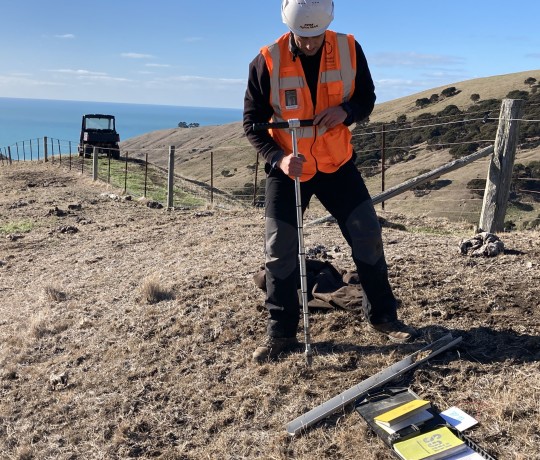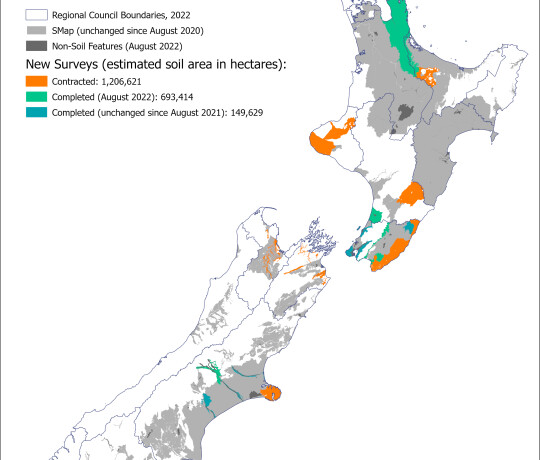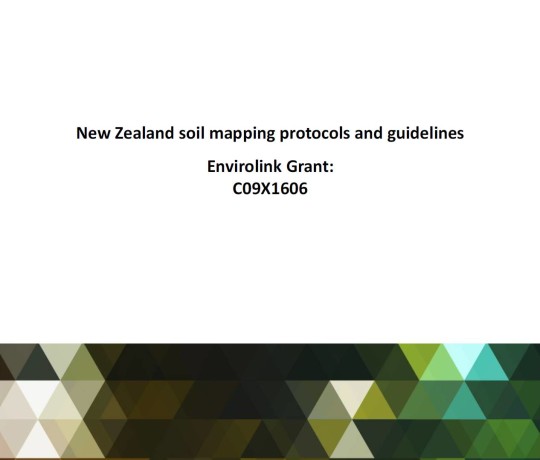Scale matters: one size does not fit all
Understanding scale is vital for interpreting soil maps
Soil surveys are conducted at various scales, depending on the purpose of mapping: from paddock/farm-scale (1:500 to 1:20,000) to catchment/regional (1:20,000 to 1:100,000) to strategic overview & broad planning maps (1:100,000 to 1:250,000). The table below shows some examples of map applications and associated common scale ranges.
Guidance on cartographic map scale, based on application or land use for conventional soil maps (after Manderson & Palmer 2006; Lynn et al. 2009)
| Selected applications | Indicative smallest area of interest to identify on map (ha) |
Indicative map scale range |
| Horticulture, market gardens, viticulture, precision farming | 0.001 to 0.1 | 1:500 to 1:5,000 |
| Pastoral, arable | 0.1 to 1 | 1:5,000 to 1:15,000 |
| Pastoral, extensive pastoral, catchment studies, forestry | 1 to 10 | 1:15,000 to 1:50,000 |
| Catchment planning, regional studies | 10 to 40 | 1:50,000 to 1;100,000 |
| Strategic overview, broad planning | 40 to 250 | 1:100,000 to 1:250,000 |
Manderson A. & Palmer A. (2006): Soil information for agricultural decision making: a New Zealand perspective. Soil Use and Management, 22, 393-400. https://doi.org/10.1111/j.1475-2743.2006.00048.x
Lynn I.H., Manderson A.K., Page M.J., Harmsworth G.R., Eyles G.O., Douglas G.B., Mackay A.D., Newsome P.J.F. (2009): Land use capability survey handbook – a New Zealand handbook for the classification of land. 3rd edn. Hamilton: AgResearch; Lincoln: Landcare Research; Lower Hutt: GNS Science. 163 p. https://doi.org/10.7931/DL1MG6
The survey scale directly impacts on the level of effort required, and survey cost. You can get a feeling for the effort required at the various cartographic scale below.
Survey site density guidance provided for conventional soil mapping
| Cartographic scale |
Area per one observation | No. of observations per unit area | ||||
| total of 1 observation per 1 cm2 of mapped area | total of 1 observation per 2 cm2 of mapped area | total of 1 observation per 4 cm2 of mapped area | total of 1 observation per 1 cm2 of mapped area | total of 1 observation per 2 cm2 of mapped area | total of 1 observation per 4 cm2 of mapped area | |
| ha/observation | observations/ha | |||||
| 1:500 | 0.0025 | 0.005 | 0.01 | 400 | 200 | 100 |
| 1:1,000 | 0.01 | 0.02 | 0.04 | 100 | 50 | 25 |
| 1:5,000 | 0.25 | 0.5 | 1 | 4 | 2 | 1 |
| 1:10,000 | 1 | 2 | 4 | 1 | 0.5 | 0.25 |
| 1:15,000 | 2.25 | 4.5 | 9 | 0.44 | 0.22 | 0.11 |
| 1:20,000 | 4 | 8 | 16 | 0.25 | 0.13 | 0.06 |
| 1:50,000 | 25 | 50 | 100 | 0.04 | 0.02 | 0.01 |
| 1:100,000 | 100 | 200 | 400 | 0.01 | 0.005 | 0.025 |
| 1:250,000 | 625 | 1250 | 2500 | 0.0016 | 0.0008 | 0.0004 |
The scale of a map is an indication of the amount of actual soil field observations that are underpinning it, and it determines the potential map application(s). A regional soil map should not and cannot be used to make farm decisions.
The level of spatial detail therefore determines the optimal spatial scale at which the map should be used. This is particularly important to consider when ‘zooming in’. Every map has a scale limit beyond which the information of the map is no longer valid. For instance, the maps provided through S-map Online are at a scale between 1:30,000 to 1:50,000. This scale is appropriate to represent soil variability at greater than ~500 m length. However, they are not detailed enough to represent soils at the scale of paddocks.
Achieving a higher level of detail comes at a cost though: It requires more soil observations on the ground, and often more detailed information on the factors that control soil formation.
Widespread implementation of farm nutrient budgets and farm environmental management plans (FEMP) greatly increases the need for accurate farm-scale soil information. And yet very few NZ farmers can currently source existing soil information at a scale and reliability that is suitable for farm management purposes (Manderson 2003; Manderson & Palmer 2006). How can this pressing issue be addressed?
Calls have repeatedly been made for a national effort for providing farm-scale soil information (Manderson & Palmer 2006, Carrick et al. 2014). The table below depicts a ‘strawman’ protocol for farmland (<15°) with multiple land use potential, with the various sources of soils information indicated. Available soils information is classed into four quality levels, from ‘poor’ to ‘premium’. It is suggested that policymakers, industry bodies, and catchment community groups can determine the most appropriate quality level required or acceptable given the context in which the soil information will be used.
Freely available S-map data – at a nominal scale of between 1:30,000 and 1:50,000 – may be considered suitable as the base level for most situations. In areas of high soil variability, a detailed 1: 10,000 soil map may be linked to the S-map factsheets to provide better information, whereas areas with intensive land use in highly sensitive catchments may require a higher level of soils information, such as detailed soil survey and site-specific measurements of key soil attributes.
‘Strawman’ proposed national standard for farm-scale soil mapping in farmland (<15°) with multiple land use potential, in relation to key land management issues. For each quality-level examples of baseline soil information are provided, but others could be added as the protocol is developed. Source: Carrick et al. (2014).
|
Farm soil map quality level |
Irrigation management |
Nutrient, soil, and sediment management |
Farm dairy effluent |
||||
|---|---|---|---|---|---|---|---|
|
|
Design |
Monitoring |
N and P leaching |
P, sediment, and bacteria runoff |
Compaction / pugging |
Design |
Monitoring |
|
Poor |
Fundament soil layer (LRIS 2014) |
Visual / tactile inspection of soil moisture |
Farm-scale LUC-based nutrient budgets |
LUC maps 1:50,000 |
Farmer awareness of area of land that pug, compact or pond after heavy rain |
Fundamental Soil layer |
Visual / tactile inspection of soil moisture |
|
Coarse scale published historical soil data (e.g., Kear et al. 1967) |
Surface ponding |
OVERSEER inputs from Fundamental Soil Layer |
Classification or top maps to identify poorly drained and artificially drained areas, sloping areas, and location of waterways and water bodies |
|
Coarse scale published historical data |
Surface ponding |
|
|
“Rules of thumb” soil attribute data |
Subsurface drains are flowing indication excess irrigation |
|
|
|
“Rules of thumb” soil attribute data |
Subsurface drains are flowing indicating excess irrigation |
|
|
Basic |
S-map derived map and factsheets (medium or high soil map quality confidence) |
Handheld soil moisture meter |
S-map derived map and factsheets (medium or high soil map quality confidence) |
10- and 25-m DEM-based landform, waterway and ‘connectivity to waterway’ maps |
S-map derived map and factsheets (medium or high soil map quality confidence) |
S-map derived map and factsheets (medium or high soil map quality confidence) |
Handheld soil moisture meter |
|
Field check of key soil types by consultant |
Desktop soil water balance scheduling |
OVERSEER soil type inputs from S-map |
On-farm identification of critical source areas |
Farm-scale LUC map |
Field check of key soil types by consultant |
Desktop soil water balance scheduling |
|
|
|
|
On-farm monitoring topsoil fertility status |
Farm-scale LUC map |
On-farm visual soil assessment (VSA guideline) |
10- and 25-m DEM-based landform, waterway and ‘connectivity to waterway’ maps |
|
|
|
Good |
Farm-scale soil map (e.g., 1:10,000 scale with high soil variability) |
On-farm soil moisture sensor on dominant soil types |
Farm-scale soil map (e.g., 1:10,000 scale in high soil variability) |
10- and 25-m DEM-based landform, waterway and ‘connectivity to waterway’ maps |
Farm-scale LUC map |
Farm-scale soil map (e.g., 1:10,000 scale in high soil variability) |
On-farm soil moisture sensor on dominant soil types |
|
Field analysis of key attributes for main soil types matched to S-map fact sheets |
Real-time soil water balance scheduling for each soil / management zone |
Field analysis of key attributes for main soil types matched to S-map fact sheets |
On-farm identification and monitoring of critical source areas |
Regular on-farm visual assessment (VSA guideline) |
Field analysis of key attributes for main soil types |
Real-time soil water balance scheduling for each soil / management zone |
|
|
|
On-farm visual soil assessment (VSA guideline) |
On-farm monitoring topsoil fertility status |
Farm-scale LUC maps |
|
Soil factsheets for each soil from S-map |
On-farm visual soil assessment (VSA guideline) |
|
|
Premium |
Farm-scale soil map with high confidence (e.g., ± 10% variance in area of each soil type) |
Replicated on-farm soil moisture sensors for each soil type |
Farm-scale soil map with high confidence (e.g., ± 10% variance in soil type area) |
< 25-m DEM-based landform, waterway and ‘connectivity to waterway’ maps |
Farm-scale soil or LUC map |
Farm-scale soil map with high confidence (e.g., ± 10% variance in area of each soil type) |
|
|
Statistically replicated field and laboratory measurements of attributes for main soil types using accredited methods |
Real-time soil water balance scheduling for each soil / management zone |
Statistically replicated attributes measurements for main soil types |
On-farm identification and monitoring of critical source areas |
Regular on-farm visual soil assessment (VSA guidelines) |
Statistically replicated attributes measurements for main soil types |
Replicated on-farm soil moisture sensors for each soil type |
|
|
|
On-farm visual soil assessment (VSA guideline) |
On-farm monitoring topsoil fertility status. |
On-farm monitoring of temporally dynamic soil attributes (e.g., infiltration rate, microporosity, topsoil fertility) |
On-farm monitoring of temporally dynamic soil attributes (e.g., infiltration rate, microporosity, topsoil fertility) |
|
Real-time soil water balance scheduling for each soil / management zone |
|
|
|
On-farm monitoring of temporally dynamic soil attributes (e.g., infiltration rate, microporosity) |
On-farm targeted leachate monitoring to validate models (e.g., lysimeters) |
|
|
|
On-farm monitoring of temporally dynamic soil attributes (e.g., infiltration rate, microporosity, topsoil fertility, visual soil assessment) |
|
References:
Manderson, A.K. 2003. Farming from the ground up: The use of land resource information as a basis for planning farm sustainability in New Zealand. PhD thesis, Massey University, Palmerston North, New Zealand. https://mro.massey.ac.nz/handle/10179/2010
Manderson A. & Palmer A. (2006): Soil information for agricultural decision making: a New Zealand perspective. Soil Use and Management, 22, 393-400. https://doi.org/10.1111/j.1475-2743.2006.00048.x
Carrick et al. (2014): S-map @ the farm scale? Towards a national protocol for soil mapping for farm nutrient budgets? http://flrc.massey.ac.nz/workshops/14/Manuscripts/Paper_Carrick_2_2014.pdf


